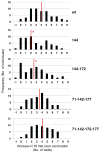Glycosylations in the globular head of the hemagglutinin protein modulate the virulence and antigenic properties of the H1N1 influenza viruses
- PMID: 23720581
- PMCID: PMC3940933
- DOI: 10.1126/scitranslmed.3005996
Glycosylations in the globular head of the hemagglutinin protein modulate the virulence and antigenic properties of the H1N1 influenza viruses
Abstract
With the global spread of the 2009 pandemic H1N1 (pH1N1) influenza virus, there are increasing worries about evolution through antigenic drift. One way previous seasonal H1N1 and H3N2 influenza strains have evolved over time is by acquiring additional glycosylations in the globular head of their hemagglutinin (HA) proteins; these glycosylations have been believed to shield antigenically relevant regions from antibody immune responses. We added additional HA glycosylation sites to influenza A/Netherlands/602/2009 recombinant (rpH1N1) viruses, reflecting their temporal appearance in previous seasonal H1N1 viruses. Additional glycosylations resulted in substantially attenuated infection in mice and ferrets, whereas deleting HA glycosylation sites from a pre-pandemic virus resulted in increased pathogenicity in mice. We then more directly investigated the interactions of HA glycosylations and antibody responses through mutational analysis. We found that the polyclonal antibody response elicited by wild-type rpH1N1 HA was likely directed against an immunodominant region, which could be shielded by glycosylation at position 144. However, rpH1N1 HA glycosylated at position 144 elicited a broader polyclonal response able to cross-neutralize all wild-type and glycosylation mutant pH1N1 viruses. Moreover, mice infected with a recent seasonal virus in which glycosylation sites were removed elicited antibodies that protected against challenge with the antigenically distant pH1N1 virus. Thus, acquisition of glycosylation sites in the HA of H1N1 human influenza viruses affected not only their pathogenicity and ability to escape from polyclonal antibodies elicited by previous influenza virus strains but also their ability to induce cross-reactive antibodies against drifted antigenic variants.
Conflict of interest statement
Figures






Similar articles
-
N-linked glycosylation of the hemagglutinin protein influences virulence and antigenicity of the 1918 pandemic and seasonal H1N1 influenza A viruses.J Virol. 2013 Aug;87(15):8756-66. doi: 10.1128/JVI.00593-13. Epub 2013 Jun 5. J Virol. 2013. PMID: 23740978 Free PMC article.
-
Genetic requirement for hemagglutinin glycosylation and its implications for influenza A H1N1 virus evolution.J Virol. 2013 Jul;87(13):7539-49. doi: 10.1128/JVI.00373-13. Epub 2013 May 1. J Virol. 2013. PMID: 23637398 Free PMC article.
-
Glycosylation on hemagglutinin affects the virulence and pathogenicity of pandemic H1N1/2009 influenza A virus in mice.PLoS One. 2013 Apr 24;8(4):e61397. doi: 10.1371/journal.pone.0061397. Print 2013. PLoS One. 2013. PMID: 23637827 Free PMC article.
-
N-linked glycosylation in the hemagglutinin of influenza A viruses.Yonsei Med J. 2012 Sep;53(5):886-93. doi: 10.3349/ymj.2012.53.5.886. Yonsei Med J. 2012. PMID: 22869469 Free PMC article. Review.
-
Playing hide and seek: how glycosylation of the influenza virus hemagglutinin can modulate the immune response to infection.Viruses. 2014 Mar 14;6(3):1294-316. doi: 10.3390/v6031294. Viruses. 2014. PMID: 24638204 Free PMC article. Review.
Cited by
-
Comparison of N-linked glycosylation on hemagglutinins derived from chicken embryos and MDCK cells: a case of the production of a trivalent seasonal influenza vaccine.Appl Microbiol Biotechnol. 2021 May;105(9):3559-3572. doi: 10.1007/s00253-021-11247-5. Epub 2021 May 3. Appl Microbiol Biotechnol. 2021. PMID: 33937925 Free PMC article.
-
Breathing and Tilting: Mesoscale Simulations Illuminate Influenza Glycoprotein Vulnerabilities.ACS Cent Sci. 2022 Dec 28;8(12):1646-1663. doi: 10.1021/acscentsci.2c00981. Epub 2022 Dec 8. ACS Cent Sci. 2022. PMID: 36589893 Free PMC article.
-
Guiding the immune response against influenza virus hemagglutinin toward the conserved stalk domain by hyperglycosylation of the globular head domain.J Virol. 2014 Jan;88(1):699-704. doi: 10.1128/JVI.02608-13. Epub 2013 Oct 23. J Virol. 2014. PMID: 24155380 Free PMC article.
-
Options and obstacles for designing a universal influenza vaccine.Viruses. 2014 Aug 18;6(8):3159-80. doi: 10.3390/v6083159. Viruses. 2014. PMID: 25196381 Free PMC article. Review.
-
Site-specific glycosylation profile of influenza A (H1N1) hemagglutinin through tandem mass spectrometry.Hum Vaccin Immunother. 2018 Mar 4;14(3):508-517. doi: 10.1080/21645515.2017.1377871. Epub 2017 Nov 17. Hum Vaccin Immunother. 2018. PMID: 29048990 Free PMC article.
References
-
- Molinari NA, Ortega-Sanchez IR, Messonnier ML, Thompson WW, Wortley PM, Weintraub E, Bridges CB. The annual impact of seasonal influenza in the US: measuring disease burden and costs. Vaccine. 2007;25:5086–5096. - PubMed
Publication types
MeSH terms
Substances
Grants and funding
LinkOut - more resources
Full Text Sources
Other Literature Sources

